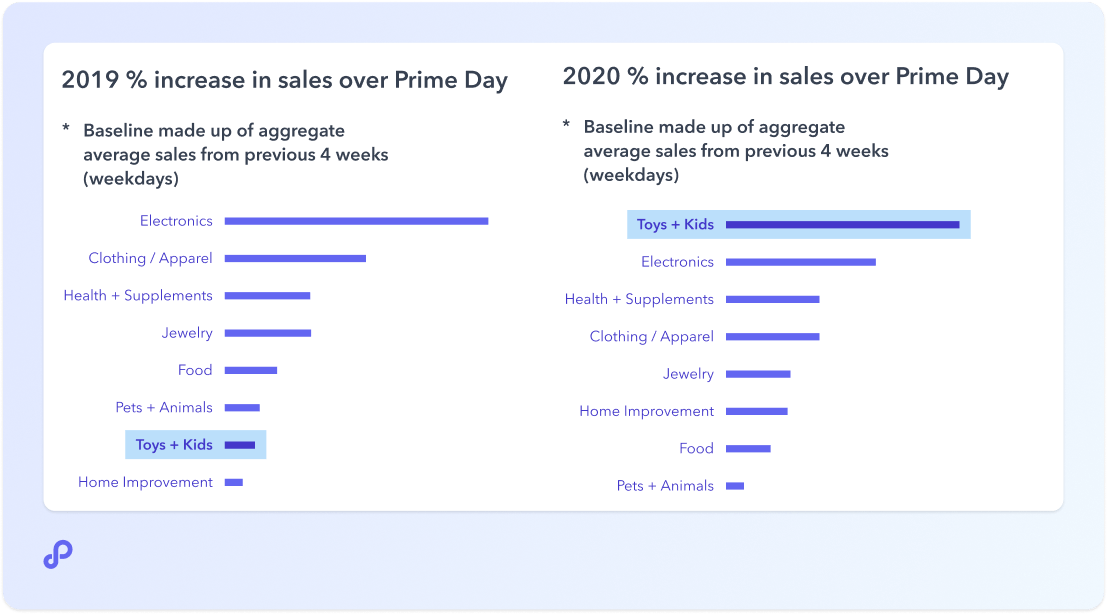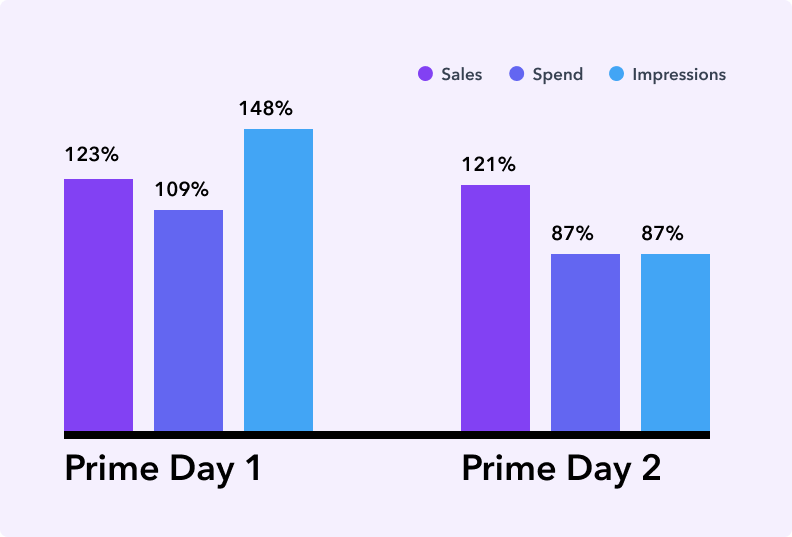
Prime Day 2022: Insights and Strategies for Success
Tiffany Luk, June 17, 2022
Advertisers — are you ready for Prime Day July 12 to 13 this year? This will be the first time since 2019 that the 48 hour signature event will again be taking place in mid July.
Each previous years’ Prime Day results indicate its growing potential for the next one. For example, from 2018 to 2019, the increase of USD 3 billion in sales exceeded the combined sales of 2017, 2016, and 2015. And while there is a sense of normalcy that we can expect in 2022 - more akin to the likes of 2019, it’s still important for us to consider past years’ performance and the impact the pandemic has had on buying behavior. That said, let’s dive in to see how you can make your July 2022 Prime Day this year a success.
Prime Day Strategies: Promotions
Beginning with the types of discounts, Lightning Deals, Coupons, and Deals of the Day all highlight the importance of being retail-ready, including budgeting ad spend and stocking up on inventory to sufficiently cover expectedly much higher projected sales and avoid getting delisted.
Looking to boost incremental sales? We recommend leveraging Lightning Deals, which appear prominently on the Prime Day deals page, and only last 4 hours. Additionally, another chance to capture bargain-hunters who may have missed these deals is with Coupons, which show up right below the price on Product Detail Page (PDP), Sponsored Products ads (SP), and the Coupons homepage, some of which are exclusive to Prime members.
Lastly, Deal of the Day promotions running for 24 out of the 48 hours are found on the Deals page, and are another great opportunity to capture sales during Prime Day from customers who may not otherwise browse this page as often throughout the year.
2019, 2020, & 2021: % Increase in Sales on Prime Day
Compared to the 2 weeks leading up to Prime Day

Despite a smaller increase in 2020’s sales during the height of the pandemic, we estimate that 2022’s performance should be more similar to 2019’s and continue to see growth beyond that of 2021, reflecting pre-pandemic shopping patterns as well as some pandemic-altered purchasing behaviors that are likely here to stay like spending more time at home and getting active exploring the outdoors.
Key takeaway: Prime Day is one of the several annual Amazon events for advertisers to capitalize on. Prepare to run all promotions you are eligible for by being retail-ready earlier than usual.
Performance by Category
Prime Day is a golden period to grow total and incremental sales by pushing your best performers.
2019, 2020, & 2021: % Increase in Sales on Prime Day & Category Ranking


In 2021, Electronics continued to be top performer, as it was in 2019, regardless of pandemic shopping behavior, given that any discount on a high-ticket item was a good deal from a customer’s perspective. However, Toys and Kids saw the most significant growth throughout the pandemic, encouraging customers to prioritize holiday shopping over buying electronics in 2020. Health and Supplements in 2019 showed a close increment of increase in sales to 2020’s, and in both years was the third highest category.
Prime Day in summer 2019 was timely for customers to complement their fitness routines with supplements while Prime Day in autumn 2020 forced consumers to take care of their health by relying more heavily on supplements than on exercise during the pandemic. Pets and Animals’ huge sales growth in 2021 was unmatched by significantly less growth in both previous years, likely due to the need for accompaniment while working from during the pandemic increasing the demand for pet adoption.
Finally, Sports and Outdoors became increasingly popular during 2021, with over 60% of consumers planning to travel domestically, explaining the purchases of products for camping, summer sports, and international travel. The need to get active also indicated the continued importance of health from previous years and doing so with outdoor experiences that also satisfy the need to travel.
Given category performance over the last few years, advertisers can expect to continue to see a shift in spend to experiences, primarily traveling and events, and to their complementary products over most non-essential goods such as high-priced electronics and home appliances, painting Prime Day 2022 a mixed picture of 2019’s & 2021’s shopping behaviors.
This year, the top categories pertaining to experiences may include: Sports & Outdoors and Home Improvement. Additionally, Health and Household may see category growth, considering that fast moving consumer goods (FMCGs) of everyday items such as home cleaning and basic personal care items are essential.
As price sensitivity continues to trump brand loyalty in 2022, advertisers may find opportunity to gain market share by introducing relatively inexpensive options and subsequently retarget customers to repeat purchase or even Subscribe and Save. If you’re in these well-performing categories, you should consider increasing your budget by more than 100% on Prime Day.
Key takeaway: Continue promoting your best performing products within their perspective categories, and start testing how products perform in categories new to you, those with high potential bolstered by the new normal.
Prime Day Strategy: Sponsored Ads
Running Sponsored Ads is one of the most powerful ways to drive traffic on Amazon to Prime Day offers.
Due to fierce Prime Day competition, cost-per-clicks (CPC) cost more on 2019 Prime Day than throughout the year, and compared to the weeks leading up to it, advertisers increased spend by 2.2x, resulting in 2.6x (+159% in USD) the attributed sales with a +98% increase in sales orders, showing very positive returns on investment (ROI).
Since higher CPCs generally occur earlier in the day during Prime Day, and CPMs increased 29% during Prime Day 2021, we recommend leveraging always-on budget optimization to prevent campaigns from going dark. To avoid losing market share, we suggest increasing your ad spend leading up to and especially during Prime Day.
It’s important to note that the increase in conversion rate (CVR) not outperforming CPC in 2019 meant that during Prime Day, transactions including those on sale, were of higher aggregate value than on non-Prime days, indicating Prime Day’s halo effect on driving incremental sales on both Prime Day deals and regularly priced items.
In 2020, compared to a baseline of aggregate average sales for the 4 weeks (weekdays) leading up to October 2020’s Prime Day, an 82% increase in ad spend on day 1 and 61% on day 2 respectively contributed to an increase of 103% on day 1 and 66% on day 2 in sales. This continues to show the effectiveness of Prime Day advertisers can leverage to generate explosive incremental and total sales in their chosen categories.
2021: Increases in Amazon Attributed Sales, Spend, and Traffic during the Leadup to and on Prime Day
Compared to the 2 weeks leading up to Prime Day

In 2021, we see that more aggressive increases in spend resulted in better sales, with the increment of the sales increases across both days nearly identical, and the biggest impression increase on day 1 being consistent with those of previous years’ Prime Day. This means that shoppers were equally eager to shop on both days, making almost as many purchases on day 2 as they did day 1, despite more having flocked to Amazon on the first day.
This year, advertisers can likely anticipate stellar sales performance on both days; however to take advantage of this trend it will be crucial to ensure the inventory of your best deals are available for both days so that your Sponsored Ads running in the lead up to and on day 1 will be eligible to continue running on day 2.
Key takeaway: Budget generously and well in advance for Sponsored Ads and focus your efforts on your best categories and products especially during Prime Day.
Prime Day Strategy: Moving Customers along the Funnel with Amazon’s Demand Side Platform (DSP)
The combination of advertising via Amazon’s DSP in conjunction with Sponsored Ads to achieve full funnel marketing objectives is a tried and true way to dominate share-of-voice in your categories.
2021: Detail Page View Rate (DPVR) by Inventory on Prime Day & the Day After
Baseline made up of average from the previous 30 days (weekdays)

2021: Purchase Rate by Inventory on Prime Day & the Day After
Baseline made up of average from the previous 30 days (weekdays)

During day 1 and day 2 of Prime Day in June 2021, we saw significant increases in DPVR and customers’ purchase rates, meaning that for the upcoming Prime Day just around the corner in July 2022, advertisers should increase their budgets, allocating for higher ad spend to increase the likelihood of conversions.
The Amazon DSP’s refined targeting (relying on its first-party data) allows full funnel advertising – reaching customers very granularly at every stage of their buying journey. Advertisers can engage shoppers with a variety of ad formats from static and display, video, to audio ads, on and off Amazon across various touch points including Amazon Owned and Operated (O&O) platforms and third-party publishers.
Before Prime Day
Beginning with brand awareness at the upper funnel and moving customers down to consideration and evaluation, we recommend increasing your spend by 150 - 200%. Targeting lifestyle and in-market audiences and complementary products are strategies that can be deployed in the lead up to Prime Day. An in-market audience who has shown high purchasing intent in certain Amazon subcategories and interest-based lifestyle audience who have habitually bought products including those in your Amazon categories are “in-aisle” shoppers who present the opportunity to be converted to new-to-brand customers.
Continue with competitor conquesting as well as contextual targeting a few days to about a week before Prime Day to capture shoppers who have not bought but viewed your competitors products or those in your brand’s subcategories. Placing your products real-time on your competitors’ Amazon PDPs or off Amazon where they are currently browsing can help move customers lower in the funnel, much closer to a conversion.
During Prime Day
When Prime Day begins, seize the opportunity to convert by retargeting customers who have specifically viewed but not bought your products. This is a great way to promote durable products including one-time purchases or high-value items. During these days and the lead out that follows, frequently bought consumables can be remarketed to encourage repeat purchases, including opting in to Subscribe and Save.
When it’s the big Prime Day, we recommend aggressively maximizing your sales by ramping up retargeting spend by 300 - 500%. Amazon found that 52% of shoppers they surveyed are very likely to rely on ads to remind them to purchase products the days after Prime, so we recommend maintaining momentum by increasing your retargeting and loyalty campaign investments in the following weeks and months to drive sales for the rest of the year from the larger-than-usual pool of audience who have now become familiar with your brand.
Leverage Amazon's DSP Creatives
These granular targeting options are complemented by advertisers’ ability to customize a variety of creatives in display ads, of which dynamic and responsive eCommerce ads are able to rotationally show images that are most likely to convert customers. To stay top-of-mind, you can also reach customers where they are through audio ads played on Amazon Music and Amazon-enabled devices including Alexa.
To increase your brand awareness even more, pair your display ads with non-skippable full-screen Streaming TV (STV) video ads within, before, or after premium streaming content viewed on platforms including FireTV, iMDb TV, Comedy Central, Food Network, Discovery Channel, and more. To move closer to a sale, captivate your customers with video ads that appear between real-time streaming content and are delivered to highly targeted audiences on the largest screen in the home. This Prime Day, take advantage of these rich and interactive ads that are available across desktop, mobile, and tablets, on Amazon, its O&O platforms, and third-party partners, aiming to engage customers in every step of their buying journey.
Key takeaway: Leverage the power of highly targeted Sponsored Ads complemented by Amazon’s DSP refined targeting options in your omnichannel Prime Day strategy with flexible ad budgets to win across your categories.
Are you set up for success? To take your advertising to the next level, from Prime Day and beyond, reach out to us at hello@perpetua.io.
To get started or learn more about how Perpetua can help you scale your Amazon Advertising business, contact us at hello@perpetua.io